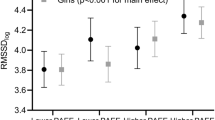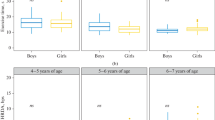Abstract
Habitual physical activity (HPA) was studied in 30 boys and 34 girls aged 6–11 years. All the children performed a shuttle run test (SRT) to assess maximal heart frequency (f cmaxSRT) and to evaluate maximal oxygen uptake (VO2maxSRT). Heart rate (f c) was measured continuously from Monday to Sunday, using a heart rate counter. The time spent at f c greater than 140 beats · min−1 (t fc>140) and at f c greater than 160 beats · min−1 (t fc>160) permitted HPA to be evaluated. The daily heart rate (f cd) and the percentage of heart rate reserve (%f crd) were calculated to evaluate the metabolic activity. In the boys and girls, f cd and %f crd varied little with age. The metabolic activity varied in a rhythmical way during the week and was higher during school days than during free days (P < 0.001). The children were more active during school days (d s) than during the free days (d f). This observation was particularly marked in the boys having t fc>140 being twice as high during d s compared to d f [t fc>140, d s 85 (SD 25), d f 40 (SD 26) min; t fc>160, d s 36 (SD 19), d f 16 (SD 13) min]. During d s t fc>160was greater in the boys than in the girls (P < 0.01) . The same held for t fc>140and % f crd from the age of 9 years (P < 0.001) . It was during the recreation periods that the differences between the boys and the girls were observed (P < 0.01). There was no significant difference between the boys and the girls during lessons, in the evening and during d f (% f crd 26–28%, t fc>14035–45 min, t fc>16010–18 min). In contrast, the children who were physically active in a sports club, had less spontaneous physical activity and %f crd, t fc>140, t fc>160and VO2maxSRT were identical to those of the other children.
Similar content being viewed by others
References
Alméras N, Mimeault N, Serresse O, Boulay MR, Tremblay (1991) A non-exercise daily energy expenditure and physical activity pattern in male endurance athletes. Eur J Appl Physiol 63:184–187
Andersen KL, Ilmarinen J, Rutenfranz J, Ottmann W, Berndt I, Kylian H, Ruppel M (1984) Leisure time sport activities and maximal aerobic power during late adolescence. Eur J Appl Physiol 52:431–436
Armstrong N, Balding J, Gentle P, Williams J, Kirby B (1990) Peak oxygen uptake and physical activity in 11 to 16 year olds. Pediatr Exerc Sci 2:349–358
Åstrand PO (1952) Experimental studies of physical working capacity in relation to sex and age. Ejnar Munksgaard, Copenhagen
Atomi Y, Iwaoka K, Hatta H, Miyashita M, Yamamoto Y (1986) Daily physical activity levels in pre-adolescent boys related to VO2max- and lactate threshold. Eur J Appl Physiol 55:156–161
Bradfield RB, Chan H, Bradfield NE, Payne PR (1971) Energy expenditures and heart rates of Cambridge boys at school. Am J Clin Nutr 24:1461–1466
Carter JEL, Heath BH (1990) Somatotyping-development and applications. University Press, Cambridge, N.Y.
Chamoux A, Levray F, Falgairette G, Gabrillargues D, Alliot J, Ponsonnaille J, Catalina MJ, Catalina P (1988) Fiabilité de certains cardiofréquencemétres existants. Rev Méd Travail 4:191–196
Cunningham DA, Stapleton JJ, MacDonald IC, Paterson DH (1981) Daily energy expenditure of young boys as related to maximal aerobic power. Can J Appl Sport Sci 4:207–211
Durant RH, Baranowski T, Davis H, Thompson WO, Puhl J, Greaves KA, Rhodes T (1992) Reliability and variability of heart rate monitoring in 3-, 4- or 5-yr-old children. Med Sci Sports Exerc 2:265–271
Durnin JVGA, Rhaman MM (1967) The assessment of the amount of fat in the human body from measurements of skinfold thickness. Br J Nutr 21:681–689
Falgairette G, Duché P, Bedu M, Fellmann N, Coudert J (1993) Bioenergetic characteristics in prepubertal swimmers; comparison with active and non-active boys. Int J Sports Med 14:444–448
Fenster JR, Freedson PS, Washburn RA, Curtis Ellison R (1989) The relationship between peak oxygen uptake and physical activity in 6-to 8-year-old children. Pediatr Exerc Sci 1:127–136
Flandrois R, Grandmontagne M, Mayet MH, Favier R, Frutoso J (1982) La consommation maximale d'oxygène chez le jeune français, sa variation avec l'âge, le sexe et l'entraînement. J Physiol (Paris) 78:186–194
Freedson PS (1989) Field monitoring of physical activity in children. Pediatr Exerc Sci 1:8–18
Glick Z, Kaufmann NA (1976) Weight and skinfold thickness changes during physical training course. Med Sci Sports 8:109–112
Hebbelinck M, Borms J (1989) Körperbauform In:Bart JA (ed) Körperliches Wachstum und Leistungsfähigkeit bei Schulkindern. VEB, Leipzig, pp 78–101
Ilmarinen J, Rutenfranz J (1980) Longitudinal studies of the changes in habitual physical activity of schoolchildren and working adolescents. In: Berg K, Eriksson B (eds) International series on sport sciences. University Park Press, Baltimore, pp 149–159
Janz KF, Golden JC, Hansen JR, Mahoney LT (1992) Heart rate monitoring of physical activity in children and adolescents:the muscatine study. Pediatrics 2:256–261
Kobayashi K, Kitamura K, Miura M, Sodeyama H, Murase Y, Miyashita M, Matzui H (1978) Aerobic power as related to body growth and training in Japanese boys:a longitudinal study. J Appl Physiol, 44:666–672
Léger L, Lambert J (1982) A maximal 20-m shuttle run test to predict VO2max. Eur J Appl Physiol 49:1–12
MacConnie SE, Gilliam TB, Geenen DL, Pels AE (1982) Daily physical activity patterns of prepubertal children involved in a vigorous exercise program. Int J Sports Med 4:202–207
Mimura KI, Kanbayashi H (1985) A fundamental study of optimum quantity of motion for children in their daily life. A change in heart rate over a period of 24 hours. J Phys Fitness Jpn 34:201–210
Pàrizková J (1968) Longitudinal study of the development of body composition and body build in boys of various physical activity. Hum Biol 40:212–225
Pirnay F (1992) Etude physiologique du test de Léger et al. Sci Sports 7:93–99
Rasmussen B (1991) Continuous heart rate measurements during shuttle run testing. In: Frenkl R, Szmodis I (eds) Children and exercise XV. Alföldi Nyomda, Debrecen, pp 217–223
Reeder AT, Stanton WR, Langley JD, Chalmers D (1991) Adolescents' sporting and leisure time physical activities during their 15th year. Can J Sport Sci 4:308–315
Sallis JF, Buono MJ, Roby JJ, Micale FG, Nelson JA (1993) Sevenday recall and other physical activity self-reports in children and adolescents. Med Sci Sports Exerc 1:99–108
Saris WHM, Binkhorst RA, Cramwinckel AB, Van Waesberghe F, Van der Veen-Hezemans AM (1980) The relationship between working performance, daily physical activity, fatness, blood lipids, and nutrition in schoolchildren. In: Berg K, Eriksson B (eds) International series on sport sciences. University Park Press, Baltimore, pp 166–174
Saris WHM, Elvers JWH, Van't Hof MA, Binkhorst RA (1986) Changes in physical activity of children aged 6 to 12 years. In: Rutenfranz J, Mocellin R, Klimt F (eds), Human Kinetics, Ill., 121–130
Sempé M, Pedron G, Roypernot MP (1979) Auxologie, méthode et séquences. Theraplix Paris, p 205
Simons-Morton BG, O'Hara NM, Parcel GS, Wei Humng I, Baranowski T, Wilson B (1990) Children's frequency of participation in moderate to vigorous physical activities. Res Q Exerc Sport 4:307–314
Sleap M, Warburton P (1992) Physical activity levels of 5–11-year-old children in England as determined by continuous observation. Res Q Exerc Sport 3:238–245
Slooten J, Kemper HCG, Post GB, Lujan C, Coudert J (1994) Habitual physical activity in 10- to 12- year-old Bolivian boys. Int J Sports Med 15 [Suppl]:S106-S111
Spady DW (1980) Total daily energy expenditure of healthy, free ranging school children. Am J Clin Nutr 33:766–775
Tanner JM (1962) Growth at adolescence. Blackwell, Oxford, p325
Verschuur R, Kemper HCG (1985) The pattern of daily physical activity. In: Kemper HCG (ed) Growth health and fitness of teenagers: longitudinal research in international perspectives. Karger, Basel: 169–186
Verschuur R, Kemper HCG, Besseling CWM (1984) Habitual physical activity and health in 13- and 14-year old teenagers. In: Illmarinen J, Valïmaki I (eds) Children and sport. Springer Berlin Heidelberg New York, pp 255–261
Yoshida T, Ishiko I, Muraoka I (1980) Effect of endurance training on cardiorespiratory functions of 5 year-old children. Int J Sports Med 1:91–94
Author information
Authors and Affiliations
Rights and permissions
About this article
Cite this article
Falgairette, G., Gavarry, O., Bernard, T. et al. Evaluation of habitual physical activity from a week's heart rate monitoring in French school children. Europ. J. Appl. Physiol. 74, 153–161 (1996). https://doi.org/10.1007/BF00376508
Accepted:
Issue Date:
DOI: https://doi.org/10.1007/BF00376508




